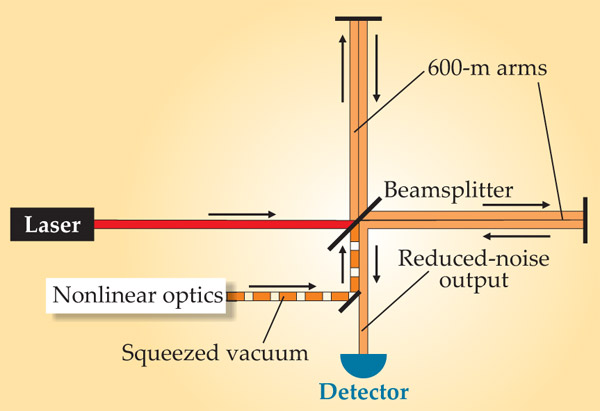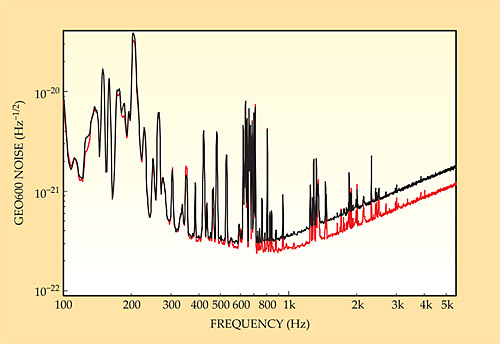Squeezed light reduces noise at a gravitational-wave observatory
DOI: 10.1063/PT.3.1316
There is little doubt that gravitational waves exist. Indirect evidence for them is compelling. But astrophysicists are keen to observe them directly for the information they can provide, and despite the efforts of teams of researchers working at extraordinarily sensitive interferometers (see, for example, the article by Barry Barish and Rainer Weiss in PHYSICS TODAY, October 1999, page 44
Any further increase in the interferometers’ sensitivity would pay off rapidly. Reducing the noise by a factor of x increases the volume of space from which an event can be detected by a factor of x3. But the interferometers are running up against the shot-noise limit: Their main source of noise, at least at the high end of their frequency band, comes from the quantum fluctuations of light, which can be interpreted as the zero-point electromagnetic fluctuations of the vacuum itself. (At lower frequencies, seismic and thermal effects are the main contributors.)
Now, Roman Schnabel (University of Hanover) and colleagues have beaten the shot-noise limit of the GEO600 interferometer near Hanover, Germany.1 GEO600 is closely connected with the Laser Interferometer Gravitational-Wave Observatory (LIGO) and is currently the only interferometer operated by the LIGO Scientific Collaboration while LIGO’s two detectors are being upgraded to Advanced LIGO (see PHYSICS TODAY, December 2010, page 31
Main squeeze
Squeezed light can be understood in terms of the Heisenberg uncertainty principle (see the article by Malvin Teich and Bahaa Saleh in Physics Today, June 1990, page 26
From the very beginning, gravitational-wave interferometry was one of the anticipated applications of squeezed light. In 1981, four years before squeezed states were first observed in the lab, Carlton Caves worked out the theory of quantum noise in a gravitational-wave detector. 2 As he showed, the interferometer’s shot noise depends critically on the zero-point fluctuations of the vacuum state entering the interferometer’s output port (the side of the beamsplitter opposite where the laser light goes in, as shown in figure 1). Injecting a squeezed vacuum state—a state of alternating regions of high and low electric-field uncertainty but with zero average electromagnetic amplitude—affects the quantum fluctuations of the light traversing the interferometer’s two arms and can ultimately reduce the noise of the output.

Figure 1. Squeezed light at the GEO600 observatory. As shown in this simplified layout, nonlinear optics generate a squeezed vacuum state, which is injected into the interferometer’s output port. The squeezed vacuum alters the quantum fluctuations of the light traversing the two 600-m arms and reduces the noise of the interferometer output.

To implement that scheme at GEO600, Schnabel and colleagues needed to vastly improve their light-squeezing capability. Squeezing degrades rapidly as light is attenuated, so squeezing by the usual 3–6 decibels (reducing the electric field variance by a factor of 2–4) would not suffice. The researchers used a squeezing factor of 10 dB—a milestone they’d reached in the lab in 2008—and the squeezing needed to be specially tailored to reduce noise over a broad range of potential gravitational-wave frequencies.
The researchers found that squeezing the vacuum by 10 dB gave an output noise reduction of 3.4 dB as measured by the variance, or a factor of 1.5 as measured by the standard deviation. As figure 2 shows, that factor is nearly constant over the high-frequency part of the band. A planned upgrade to GEO600 should more than halve the optical losses and almost double the benefit of squeezing. And an international team, led by researchers at MIT and the Australian National University and including Schnabel and his group, is working on testing squeezed light at one of the two LIGO detectors.

Figure 2. Interferometer noise at GEO600 with (red) and without (black) the use of squeezed light. At frequencies above 700 Hz, where quantum fluctuations are the main source of noise, the noise is reduced by a factor of about 1.5. That reduction increases the accessible volume of sky by a factor of 1.53, or 3.4. (Adapted from ref.

Of all the envisioned applications of squeezed light, enhancement of a gravitational-wave observatory is the first to be implemented on a large scale. Others, including quantum communication and quantum computation, remain at the proof-of-principle stage. Says Aephraim Steinberg of the University of Toronto, “When I started learning about squeezed light about 20 years ago, I thought the original motivation of improved gravitational-wave sensitivity was a beautiful idea that would probably always remain in the realm of science fiction. This is a landmark paper.”
References
1. LIGO Scientific Collaboration, Nat. Phys. (in press),.https://doi.org/10.1038/nphys2083
2. C. M. Caves, Phys. Rev. D 23, 1693 (1981).https://doi.org/10.1103/PhysRevD.23.1693
